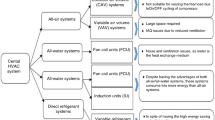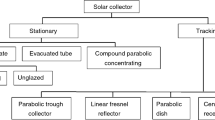Abstract
Mechanical draft cross flow cooling towers are generally used in a large-scale water cooled condenser based air-conditioning plants for removing heat from warm water which comes out from the condensing unit. During this process considerable amount of water in the form of drift (droplets) and evaporation is carried away along with the circulated air. In this paper, the performance evaluation of a standard cross flow induced draft cooling tower in terms of water loss, range, approach and cooling tower efficiency are presented. Extensive experimental studies have been carried out in three cooling towers employed in a water cooled condenser based 1200 TR A/C plant over a period of time. Daily variation of average water loss and cooling tower performance parameters have been reported for some selected days. The reported average water loss from three cooling towers is 4080 l/h and the estimated average water loss per TR per h is about 3.1 l at an average relative humidity (RH) of 83%. The water loss during peak hours (2 pm) is about 3.4 l/h-TR corresponding to 88% of RH and the corresponding efficiency of cooling towers varied between 25% and 45%.















Similar content being viewed by others
Abbreviations
- A/C:
-
Air conditioning
- TR:
-
Ton of refrigeration
- RH:
-
Relative humidity
- TWL:
-
Theoretical water loss
- OTWL:
-
Overall theoretical water loss
- AWL:
-
Actual water loss
- ω:
-
Specific humidity, kg/kg of dry air
- \({\dot{\text{m}}}\) :
-
Mass flow rate, l/s
- ∆T:
-
Temperature difference, °C
- η:
-
Efficiency, %
- Win :
-
Hot water inlet
- Wout :
-
Cold water outlet
- WBT:
-
Wet bulb temperature
- DBT:
-
Dry bulb temperature
- v:
-
Water vapour
- W:
-
Chilled water
References
M. Lucasa, P.J. Martinez, A. Viedma, Experimental determination of drift loss from a cooling tower with different drift eliminators using the chemical balance method. Int. J. Refrig. 35, 1779–1788 (2012)
W.H. Walker, W.K. Lewis, W.H. McAdams, Principles of Chemical Engineering (McGraw-Hill, New York, 1923)
V.D.I. Merkel, Verdunstungskiihlung, vol. 275 (Forschungsarbeiten, Berlin, 1925)
H.B. Nottage, Merkel’s cooling diagram as a performance correlation for air-water evaporative cooling systems. ASHRE Trans. 47, 429–448 (1941)
Lichtenstein, Performance and selection of mechanical-draft cooling towers. ASME Trans. 65, 779–787 (1943)
H.S. Mickley, Design of forced draft air conditioning equipment. Chem. Eng. Prog. 45, 739–745 (1949)
W.M. Simpson, T.K. Sherwood, Performance of small mechanical draft cooling towers. Refrig. Eng. 52(535–543), 574–576 (1946)
L.D. Berman, Evaporative Cooling of Circulating Water, vol. 2 (Pergamon, Bergama, 1961)
U.J.L. Threlkeld, Thermal Environmental Engineering, vol. 11 (Prentice-Hall, New Jersey, 1970)
G. Yadigaroglu, E.J.Pastor, An Investigation of the Accuracy of the Merkel Equation for Evaporative Cooling Tower Calculations, ASME Paper 74, (1974)
A. Whillier, A fresh look at the calculation of performance of cooling towers. ASHRAE Trans. 82, 269–282 (1976)
A.N. Nahavandi, R.M. Kershah, B.J. Serico, The effect of evaporation losses in the analysis of counter flow cooling towers. Nucl. Eng. Des. 32, 29–36 (1975)
F. Osterle, On the analysis of counter-flow cooling towers. Int. J. Heat Mass Transf. 34, 1313–1316 (1991)
J.E. Braun, S.A. Klein, J.W. Mitchell, Effectiveness models for cooling towers and cooling coils. ASHRAE Trans. 95, 164–174 (1989)
J.W. Suthedand, Analysis of mechanical draught counterflow air/water cooling towers. Int. J. Heat Transf. 105, 576–583 (1983)
M.A. Bernier, Cooling tower performance: theory and experiments. ASHRAE Trans. 100, 114–121 (1994)
M.A. Bernier, Thermal performance of cooling towers. ASHRAE J. 37, 56–61 (1995)
M.A. Nimr, Modeling the dynamic thermal behavior of cooling towers containing packing materials. Heat Transf. Eng. 20, 91–96 (1999)
C. Ren, An analytical approach to the heat and mass transfer processes in counterflow cooling towers. ASME J. Heat Transf. 128, 1142–1148 (2006)
A.S. Jose, The use of thermo-fluid dynamic efficiency in cooling towers. Heat Transf. Eng. 23, 22–30 (2002)
M. Kintner-Meyer, A.F. Emery, Cost-optimal analysis of cooling towers. ASHRAE Trans. 100, 92–101 (1994)
J.R. Khan, S.M. Zubair, Performance characteristics of counter flow wet cooling towers. Int. J. Energy Conversat. Manag. 44, 2073–2091 (2002)
S.P. Fisenko, A.A. Brin, A.I. Petruchik, Evaporative cooling of water in a mechanical draft cooling tower. Int. J. Heat Mass Trans. 47, 165–177 (2004)
S.J. Arceivala, Water Conditioning for Cooling Towers, Spray Ponds etc (Central Public Health Engineering Research Institute, Nagpur, 1971)
C.G.Nirmal, Air-cooled: myths and facts. Air Cond. Refrig. J., 03–15 (2003)
Acknowledgement
The authors express their sincere thanks to IIT Guwahati, Sterling and Wilson Company private Limited, Kolkata Branch and Trane Company private limited, Kolkata Branch for providing the necessary technical support during the experiment.
Author information
Authors and Affiliations
Corresponding author
Rights and permissions
About this article
Cite this article
Muthukumar, P., Naik, B.K. & Goswami, A. Performance Evaluation of a Mechanical Draft Cross Flow Cooling Towers Employed in a Subtropical Region. J. Inst. Eng. India Ser. C 100, 333–341 (2019). https://doi.org/10.1007/s40032-018-0441-y
Received:
Accepted:
Published:
Issue Date:
DOI: https://doi.org/10.1007/s40032-018-0441-y




